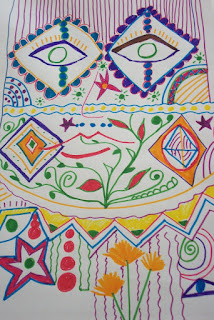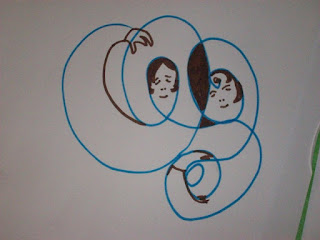 Staring at a blank page can be intimidating to say the least. Where to begin? What color to choose? What if I make a mistake? What will others think? What if it's not good enough? These concerns are all the voice of our internal critic playing havoc on our psyche. These messages might be the result of some childhood experience with art or any other experience, where we were told something to the effect of, that's not how you draw a (fill in the blank.) The internal critic is the creature who resides inside of us telling us that we are not good enough or perfect enough.
Staring at a blank page can be intimidating to say the least. Where to begin? What color to choose? What if I make a mistake? What will others think? What if it's not good enough? These concerns are all the voice of our internal critic playing havoc on our psyche. These messages might be the result of some childhood experience with art or any other experience, where we were told something to the effect of, that's not how you draw a (fill in the blank.) The internal critic is the creature who resides inside of us telling us that we are not good enough or perfect enough.I remember a creative writing course I took years ago, where we were asked to write about why we were taking the course. I begin my piece by saying that I was taking the course because....As students began to read what they had written, I became numb and wanted to leave the room asap. When the instructor asked what I had written a chill encased my body and I said something to the effect of, "it is not very good and..." The instructor responded, we are all at different places with our writing and you must respect where you are in this creative journey. Hey, I like that I thought. Respect where I am in the process. That makes sense. Whether you are writing, painting, engaging in another creative or self-expressive process, respect where you are in the process. Beginnings can be challenging, but what are the consequences of not beginning? Where would we be if we did not crawl, sit up or walk? The same is true for the creative process. When I began writing poetry, I was told to begin with,"this is a poem about..." I could always go back later and change the first line. The same is true for art, though we can't always change the images, we can add to them, we can add color or shapes to them and we can allow ourselves to be present with the process instead of thinking about the product.
Tip 1: begin with collage - it is less intimidating than drawing. Though you can begin drawing experimenting with color, shape and images.
Tip 2: Focus on process
Tip 3: Remember to have fun
Tip 4: Tap into your beginnner's mind
Tip 5: Leave perfection at the door
Tip 6: Invite imperfection in
Tip 7: Let your heart speak
Next time you come across a blank page, ask it what it wants from you, where it would like you to begin and allow your heart to speak.




